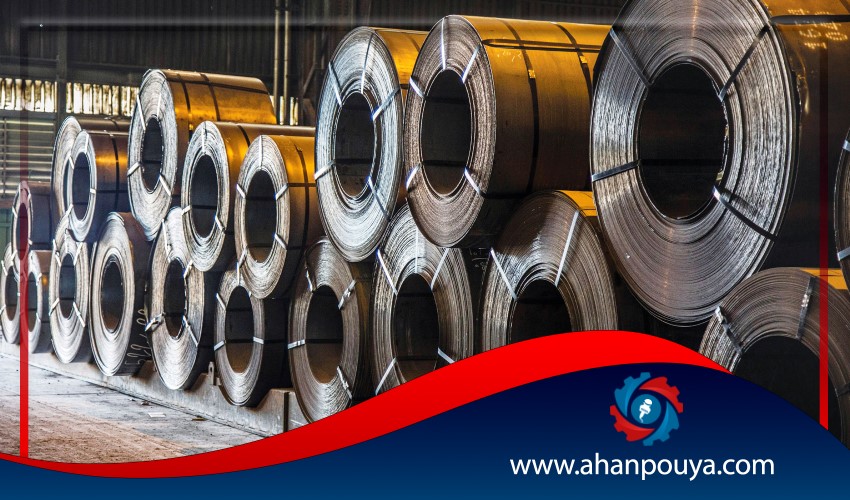
Steel has long been described as an alloy of iron and carbon.But today, according to the standard definition, steel is a material in which the amount of iron is more than any other element and generally its carbon content is less than 2% and also contains other elements. a limited number of chromium steels may have more than 2 % carbon , but the highest percentage of carbon is the boundary between steel and iro. n
It is now more than 90 % of the world 's global production of metals And its unique features such as: strength, softness, flexibility, reasonable price and recyclability make it an irreplaceable and unrivaled metal.
:history of steel
The first case of iron extraction dates back to around 1300 BC . the first major steel production began in india using the way they recognized the ancient egyptians . This method is called the "Watts" process and its product is sponge steel.
types of steel
steels can be classified in different ways . the most important category of steel is its alloying elements . In terms of alloying elements , it is classified into two classes of simple carbon steels and alloy steels . the properties of simple carbon steels usually depend on the amount of carbon in them while the properties of alloy steels depend on the type and amount of alloying elements present in them.
plain carbon steel
the most common type of steel is simple carbon steel . It defines steel , including iron and carbon , with small amounts of manganese , silicon , or aluminum And is classified into three categories: low carbon - medium carbon and high carbon.
low carbon steel
where the percentage of carbon in them is less than 0.2 % . It has a good deal of flexibility and toughness and they are well shaped. these alloys have a good weldability . And they are used in electrical and machine industries such as wires, pipes and steel sheets such as ST52 sheets.
medium carbon steels
the percentage of carbon in the steel is varied between 0.2 and 0.6 % . Its hardness and tensile strength are higher than the low carbon type But their flexibility and weldability are low. it is used in the manufacture of steam , tools , and bolts .
High carbon steels
It has more than 0.6 % carbon . Increasing the percentage of carbon will increase the hardness and tensile strength of steel but its flexibility is drastically reduced . These steels are almost not welded. these are used in making hard tools such as cutting tools , springs , cutlery , and forks .
Alloy steels
another important type of steel is alloy steel . In addition to the elements mentioned above, significant amounts of elements such as chromium, nickel and molybdenum distinguish it from plain carbon steel. Alloy steel can be low alloy, high alloy or micro alloy (HSLA). A special part of alloy steels are stainless steels that have at least 11.5 percent cream.
steel tools
Steels are used to make tools needed for cutting, shaping, and other processes required to convert metallic and non-metallic materials into desired shapes. It should be noted that some steels are used in the form of steel castings, but on most steel parts mechanical work is done to reach the final shape and for this reason they are called wrought products.
steel production
there are two common ways of producing steel :
Blast furnace method
In this way , the iron ore is crushed and sifted through mine mining . Crushed iron ore with some coke powder and limestone entered the blast furnace. And with them, hot air is blown into the furnace. the iron ore has been reduced in the presence of hot air And it 's getting up in the bottom of the furnace . The resulting product is called pig iron .
Direct Relief Method
in the direct regeneration method , concentrate the quarry 's stone and turn it into a rock . After separating the remaining small pellets, they are transferred to a direct reduction unit. In direct rehabilitation units , iron ore is taken and it is converted into a product called spong iron . The sponge iron obtained from this section enters the electric arc furnace with a percentage of scrap iron for melting. At this stage, the impurities in the sponge iron along with a small amount of iron oxide are separated from the molten steel in the form of slag and the molten steel is ready to be loaded.
Convert molten steel to final shape
Steels are produced in molten state. And before making more processes , they need to be solid. in industrial processes freezing is done in two different ways . In the first method, molten steel is poured into rectangular molds to solidify ingot.
in the second method which is more common Ingots, ingots or slabs are made directly from molten iron by continuous casting. In this process, molten steel is cooled by a stream of water at the top of the mold, the end of which is open. so that solid steel is continuously withdrawn from the bottom of the mold . To achieve the desired properties for specific engineering applications, most final products require a combination of heat treatment and molding operations.
steel applications
Using hot and cold rolling, a wide range of steel products including sheets, sheets, pipes, tubes, sections, rebars, wires and… is obtained. that are either used directly or with complementary production processes . On the other hand, we have a casting process that helps to produce a wide range of versatile products. If the carbon content of the steel exceeds three tenths of a percent, it will be used to make products such as bolts, shafts, gears and crankshafts.
High carbon steels that have high mechanical strength are suitable for making tools such as saws, blades and springs.

Ahan Pouya with more than a decade of best-selling experience, adheres to professional and ethical principles in the field of selling and buying at inside and outside the borders of Iran, helping you in the steel industry.